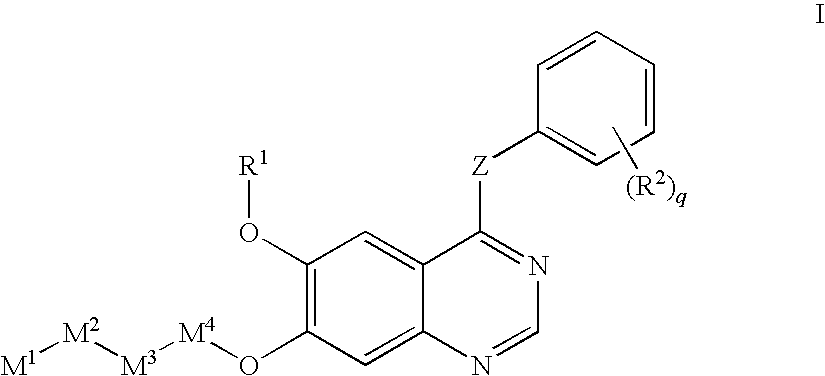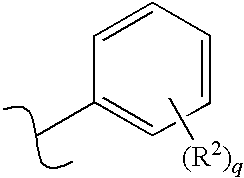Receptor-type kinase modulators and methods of use
a kinase and receptor-type technology, applied in the field of compounds for modulating protein kinase enzymatic activity, can solve problems such as altered cellular properties, and achieve the effect of improving the specificity of the agents used
- Summary
- Abstract
- Description
- Claims
- Application Information
AI Technical Summary
Benefits of technology
Problems solved by technology
Method used
Image
Examples
example 1
1,4:3,6-Dianhydro-2-O-[4-[(3-chloro-2-methylphenyl)amino]-6-(methyloxy)quinazolin-7-yl]-5-O-methyl-L-iditol
[0318]1,4:3,6-dianhydro-2-O-methyl-5-O-(methylsulfonyl)-D-glucitol: To a solution of 1,4:3,6-dianhydro-2-O-methyl-D-glucitol (1.19 g, 7.4 mmol) in dichloromethane was added pyridine (1 mL, 12.36 mmol) followed by methanesulfonyl chloride (0.69 mL, 8.92 mmol) and the mixture was allowed to stir at room temperature over 12 hours. The solvent was removed and the amorphous residue was partitioned between ethyl acetate and aqueous hydrochloric acid (for example 0.1M HCl). The aqueous phase was extracted once with additional ethyl acetate and the combined organic layers were washed with saturated aqueous sodium chloride then dried over anhydrous magnesium sulfate. Filtration and concentration followed by drying in vacuo afforded 1,4:3,6-dianhydro-2-O-methyl-5-O-(methylsulfonyl)-D-glucitol (1.67 g, 94% yield) as a colorless oil. GCMS calculated for C8H14SO6: 238 (M+).
[0319]4-[(3,4-dic...
example 2
1,4:3,6-Dianhydro-5-O-[4-[(4-bromo-3-chlorophenyl)amino]-6-(methyloxy)-quinazolin-7-yl]-L-sorbose ethylene glycol acetal
[0338]1,4:3,6-dianhydro-5-O-(phenylcarbonyl)-D-fructose ethylene glycol acetal: A solution of 1,4:3,6-dianhydro-5-O-(phenylcarbonyl)-D-fructose (2.00 g, 8.06 mmol), ethylene glycol (5.00 g, 80.6 mmol), and p-toluenesulfonic acid (1.53 g, 8.06 mmol) in benzene (100 mL) was refluxed for 90 min using a Dean-Stark Trap apparatus. The reaction mixture was diluted with ethyl acetate (100 mL), washed with saturated aqueous sodium bicarbonate (2×50 mL) then brine (50 mL), and dried over anhydrous sodium sulfate. Filtration, concentration and column chromatography on silica (1:1 hexane / ethyl acetate) provided 1.44 g (61% yield) of 1,4:3,6-dianhydro-5-O-(phenylcarbonyl)-D-fructose ethylene glycol acetal as a colorless solid. 1H NMR (400 MHz; CDCl3): 8.08 (m, 2H), 7.58 (m, 1H), 7.54 (m, 2H), 5.38 (dd, 1H), 4.97 (t, 1H), 4.21-4.02 (m, 7H), 3.86 (d, 1H), 3.75 (d, 1H).
[0339]1,4:...
example 3
1,4:3,6-Dianhydro-2-O-[4-[(4-bromo-3-chlorophenyl)amino]-6-(methyloxy)-quinazolin-7-yl]-5-deoxy-5-methylidene-D-xylo-hexitol
[0342]1,4:3,6-dianhydro-2-deoxy-2-methylidene-D-arabino-hexitol: To a solution of 1,4:3,6-dianhydro-2-deoxy-2-methylidene-5-O-(phenylcarbonyl)-D-arabino-hexitol (329 mg, 1.34 mmol) in methanol (10 mL) was added 50% aqueous sodium hydroxide (95 mg, 1.19 mmol) and the mixture was stirred at room temperature for 30 minutes. Neutralization with 4M hydrogen chloride in 1,4-dioxane, followed by concentration and column chromatography on silica (1:1 hexane / ethyl acetate) provided 141 mg (74%) of 1,4:3,6-dianhydro-2-deoxy-2-methylidene-D-arabino-hexitol as a colorless solid. 1H NMR (400 MHz; CDCl3): 5.37 (m, 1H), 5.20 (m, 1H), 4.80 (m, 1H), 4.54 (m, 2H), 4.43 (m, 1H), 4.26 (m, 1H), 3.95 (dd, 1H), 3.54 (dd, 1H), 2.70 (d, 1H).
[0343]1,4:3,6-dianhydro-2-deoxy-2-methylidene-5-O-(methylsulfonyl)-D-arabino-hexitol: To a solution of 1,4:3,6-dianhydro-2-deoxy-2-methylidene-D-ar...
PUM
 Login to View More
Login to View More Abstract
Description
Claims
Application Information
 Login to View More
Login to View More - R&D
- Intellectual Property
- Life Sciences
- Materials
- Tech Scout
- Unparalleled Data Quality
- Higher Quality Content
- 60% Fewer Hallucinations
Browse by: Latest US Patents, China's latest patents, Technical Efficacy Thesaurus, Application Domain, Technology Topic, Popular Technical Reports.
© 2025 PatSnap. All rights reserved.Legal|Privacy policy|Modern Slavery Act Transparency Statement|Sitemap|About US| Contact US: help@patsnap.com



